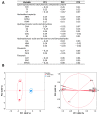Comparison of Phenolic Compounds and Evaluation of Antioxidant Properties of Porophyllum ruderale (Jacq.) Cass (Asteraceae) from Different Geographical Areas of Queretaro (Mexico)
- PMID: 37896032
- PMCID: PMC10609970
- DOI: 10.3390/plants12203569
Comparison of Phenolic Compounds and Evaluation of Antioxidant Properties of Porophyllum ruderale (Jacq.) Cass (Asteraceae) from Different Geographical Areas of Queretaro (Mexico)
Abstract
Porophyllum ruderale (P. ruderale) is a well-known Mexican plant from the group of "Quelites", widely consumed plant species used for several food and medicinal purposes. As the production is very heterogeneous and the diverse agroclimatic conditions significantly impact the plant's phytochemical composition, this research aimed to compare the phenolic compound composition and the antioxidant capacity of the P. ruderale plant from three different collection sites (Queretaro, Landa de Matamoros, and Arroyo Seco) in the State of Queretaro (Mexico). Plants collected from Queretaro displayed the lowest total phenolic compounds, flavonoids, and condensed tannins, reflected in a lower antioxidant capacity (DPPH, FRAP, ABTS), compared to the other collection places. Flavones (epicatechin and epigallocatechin gallate) were the most abundant (36.1-195.2 μg equivalents/g) phenolics quantified by HPLC-DAD, while 31 compounds were identified by UHPLC-DAD-QToF/MS-ESI. Most compounds were linked to biological mechanisms related to the antioxidant properties of the leaves. A PCA analysis clustered Landa de Matamoros and Arroyo Seco into two groups based on flavones, hydroxybenzoic acids, the antioxidant capacity (ABTS and DPPH), and total phenolic compounds, the main contributors to its variation. The results indicated contrasting differences in the polyphenolic composition of collected P. ruderale in Queretaro, suggesting the need to standardize and select plants with favorable agroclimatic conditions to obtain desirable polyphenolic compositions while displaying potential health benefits.
Keywords: Porophyllum ruderale; antioxidant capacity; bioactive compounds; phenolic compounds.
Conflict of interest statement
The authors declare no conflict of interest.
Figures




References
-
- Santiago-Saenz Y.O., Monroy-Torres R., Rocha-Amador D.O., Hernández-Fuentes A.D. Effect of a Supplementation with Two Quelites on Urinary Excretion of Arsenic in Adolescents Exposed to Water Contaminated with the Metalloid in a Community in the State of Guanajuato, Mexico. Nutrients. 2020;12:98. doi: 10.3390/nu12010098. - DOI - PMC - PubMed
-
- Alonso-Castro A.J., Domínguez F., Maldonado-Miranda J.J., Castillo-Pérez L.J., Carranza-Álvarez C., Solano E., Isiordia-Espinoza M.A., del Carmen Juárez-Vázquez M., Zapata-Morales J.R., Argueta-Fuertes M.A., et al. Use of Medicinal Plants by Health Professionals in Mexico. J. Ethnopharmacol. 2017;198:81–86. doi: 10.1016/j.jep.2016.12.038. - DOI - PubMed
-
- Fukalova-Fukalova T., García-Martínez M.D., Raigón M.D. Nutritional Composition, Bioactive Compounds, and Volatiles Profile Characterization of Two Edible Undervalued Plants: Portulaca Oleracea L. and Porophyllum Ruderale (Jacq.) Cass. Plants. 2022;11:377. doi: 10.3390/plants11030377. - DOI - PMC - PubMed
Grants and funding
LinkOut - more resources
Full Text Sources
Research Materials
Miscellaneous

